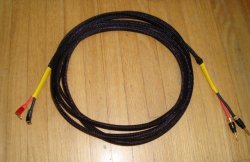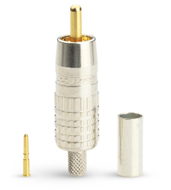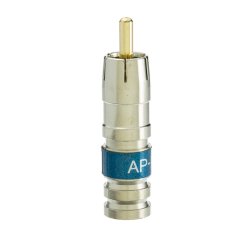Matthew J Poes
AV Addict
Thread Starter
- Joined
- Oct 18, 2017
- Messages
- 1,903
I'm looking to do an article on DIY speaker cables, interconnects, etc. It will cover a range of ways to build your own cables at modest prices. I'll readily admit that material costs for DIY will always exceed the absolute cheapest cables one could buy (or the free ones often included) but the quality is still a good bit better. I'll include measurements of the resistance, capacitance, and inductance of these cables.
I'm curious the range of cable's people use. Did you make your own? Free stuff included? High-end?
In my own system I have a mix of cables from a variety of manufacturers and of my own creation. I have pure silver tri-braid cables I made with bullet RCA connectors as I was curious if silver really sounded any different. The cost to make them was less than $40. I have a bunch of BlueJeans Cables' RCA LC1 with Canare RCA connectors for a few connections as well as longer subwoofer runs. I have Zu Audio cables sent to me as samples to test out years ago.
For speaker cables I currently use OFC copper in wall, standard grade, high strand count, and 12 gauge. It's finished with copper BFA connectors I had, not sure where I got them. I've built probably over 100 different audiophile speaker cables in the past, though none of them were/are long enough to run to my speakers in the current system. I can share how to create some of these cables for anyone interested.
I'm not going to delve deeply into any sonic differences among cables as the goal of this and the upcoming article is to focus on getting the job done. If for no other reason, I like to have robust cables in my system to prevent problems due to damage. I've had cheap cables fail quite a bit, even untouched ones. Given the frequency with which I disconnect equipment in my system, having a decent cable makes sense. I also like to tinker and RCA, power, and speaker cables were all an easy target for the DIYer.
My current favorite line level connection is balanced due to its inherently better shielding and noise cancelation along with the more robust locking connectors that are available cheaply. My current favorite speaker connector is speakon. Nothing I've used is as robust, and in discussion with a number of amplifier engineers and an interesting incident with the measurements of a very low noise amplifier in stereophile, I've come to learn that it is by far the lowest noise and most reliable connection on the market (Phoenix is also very good but more uncommon, and harder to use). Starting a few years back I started buying Speakon in bulk and building all my projects with speakon connectors. They are not expensive, handle a ton of current, are easy to connect and lock in place, are durable if pulled on, and won't add any noise ever.
I also like the look of a well finished cable and so I like to add heat shrink and techflex. While it has no real performance advantage, it just looks more professional. I'll upload some pics later when I get a chance.
I'm curious the range of cable's people use. Did you make your own? Free stuff included? High-end?
In my own system I have a mix of cables from a variety of manufacturers and of my own creation. I have pure silver tri-braid cables I made with bullet RCA connectors as I was curious if silver really sounded any different. The cost to make them was less than $40. I have a bunch of BlueJeans Cables' RCA LC1 with Canare RCA connectors for a few connections as well as longer subwoofer runs. I have Zu Audio cables sent to me as samples to test out years ago.
For speaker cables I currently use OFC copper in wall, standard grade, high strand count, and 12 gauge. It's finished with copper BFA connectors I had, not sure where I got them. I've built probably over 100 different audiophile speaker cables in the past, though none of them were/are long enough to run to my speakers in the current system. I can share how to create some of these cables for anyone interested.
I'm not going to delve deeply into any sonic differences among cables as the goal of this and the upcoming article is to focus on getting the job done. If for no other reason, I like to have robust cables in my system to prevent problems due to damage. I've had cheap cables fail quite a bit, even untouched ones. Given the frequency with which I disconnect equipment in my system, having a decent cable makes sense. I also like to tinker and RCA, power, and speaker cables were all an easy target for the DIYer.
My current favorite line level connection is balanced due to its inherently better shielding and noise cancelation along with the more robust locking connectors that are available cheaply. My current favorite speaker connector is speakon. Nothing I've used is as robust, and in discussion with a number of amplifier engineers and an interesting incident with the measurements of a very low noise amplifier in stereophile, I've come to learn that it is by far the lowest noise and most reliable connection on the market (Phoenix is also very good but more uncommon, and harder to use). Starting a few years back I started buying Speakon in bulk and building all my projects with speakon connectors. They are not expensive, handle a ton of current, are easy to connect and lock in place, are durable if pulled on, and won't add any noise ever.
I also like the look of a well finished cable and so I like to add heat shrink and techflex. While it has no real performance advantage, it just looks more professional. I'll upload some pics later when I get a chance.
















